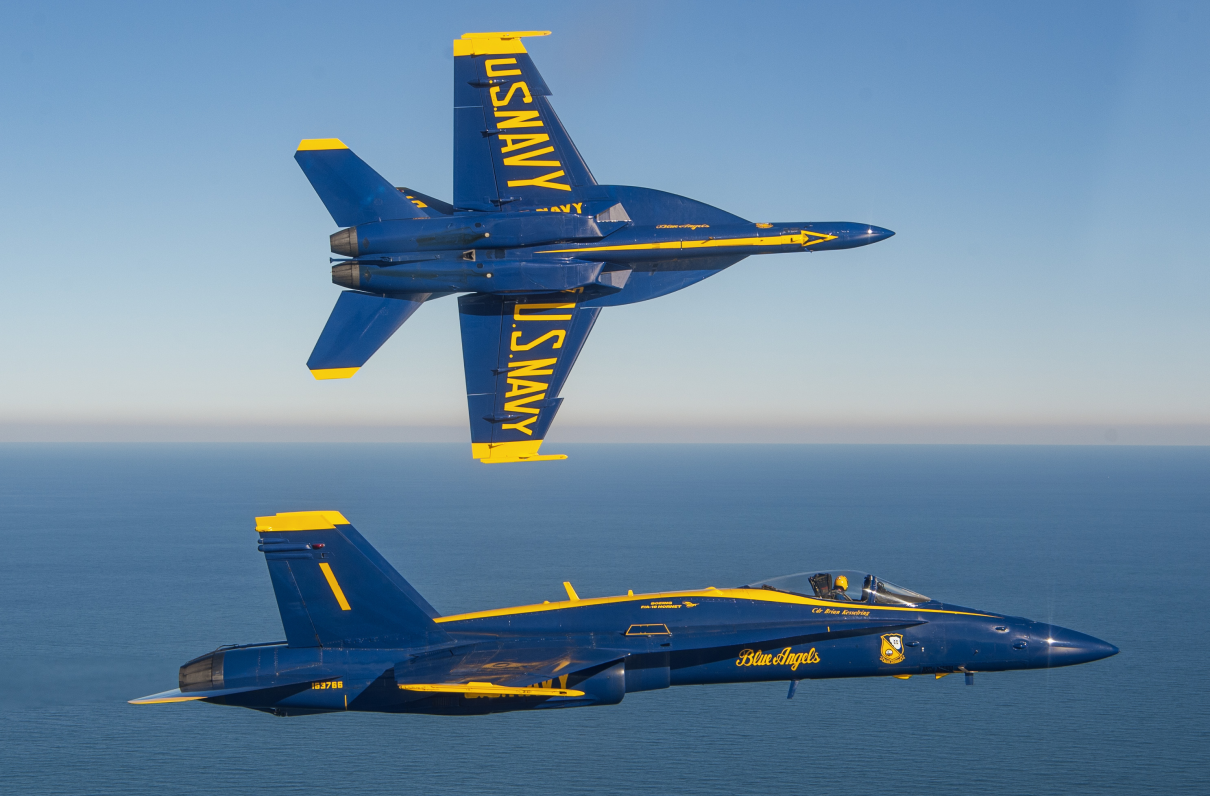(This article by Christopher P. Cavas originally appeared in the April 2021 issue of Military Officer, a magazine available to all MOAA Premium and Life members. Learn more about the magazine here; learn more about joining MOAA here.)
They are the stars of every air show. Thousands of heads pivot to follow them high in the sky as they break into a symmetrical split. Eyes squint as the aircraft all but disappear, then widen as the dots plunge directly toward the earth.
Ears are pummeled as the planes get louder and closer, and the noise builds to a huge crescendo as mighty engines come ever nearer. Then the ground shakes and chests pound as gleaming blue jets rush low in full view of the crowd, their afterburning engines glowing hot to muster full military power as they pass and climb again.
That visceral experience is the heart of the Navy’s flight demonstration team, known worldwide as the Blue Angels. It’s an excitement that transcends military and civilian, young and old, north, south, and anywhere else.
“They’re not only the face of the Navy, in the most visible manner possible,” said Capt. Russ Bartlett, USN (Ret), a former team “boss” who commanded the Blue Angels from 2002 to 2004.
“What it’s really all about is connecting with the people of the country, demonstrating a little bit about what the Navy and Marine Corps are all about. And generating interest, especially in kids, from a very young age,” he told Military Officer.
This year is a milestone for the Blue Angels, marking 75 years since the team was formed. And this show season, spectators can see the team’s new aircraft, the F/A-18E Super Hornet.
Blue Angels Aircraft Through the Years
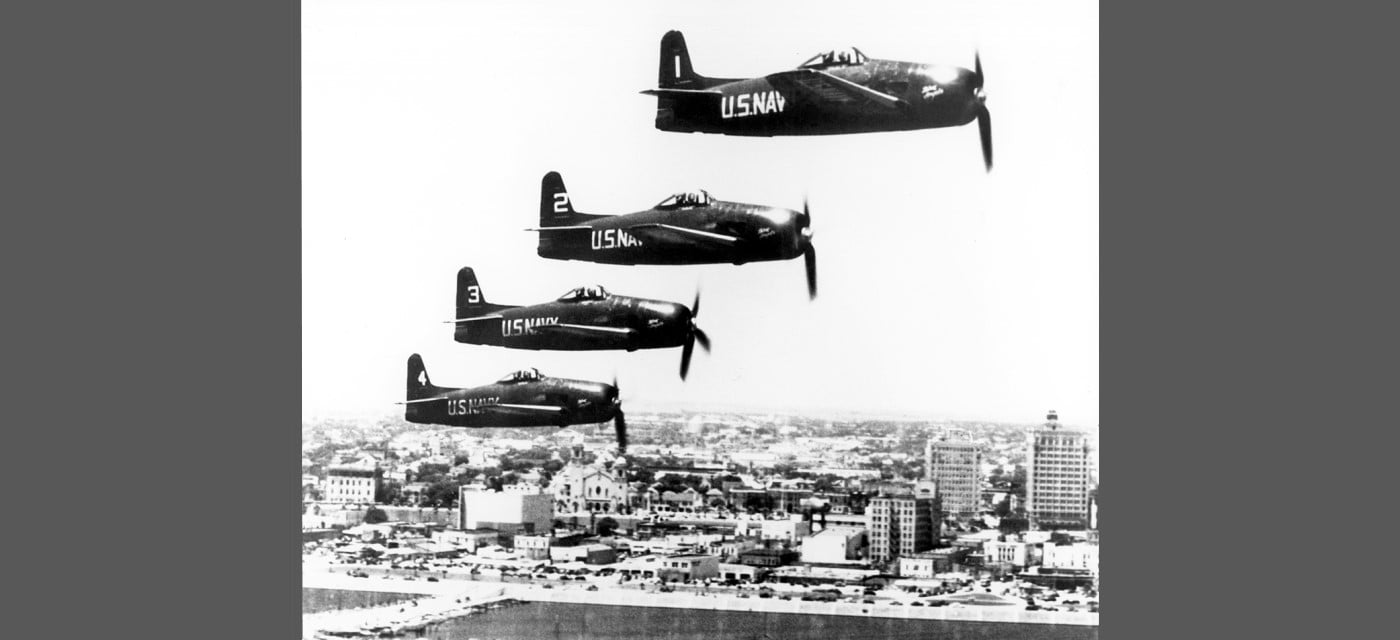
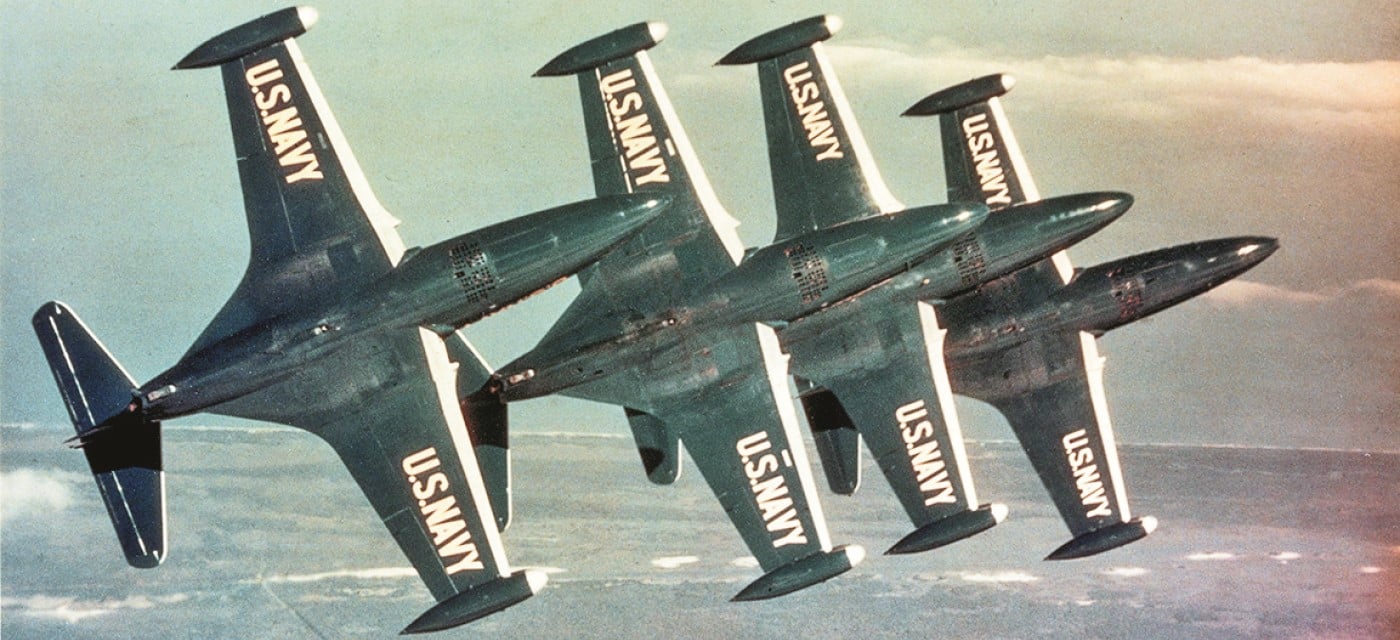
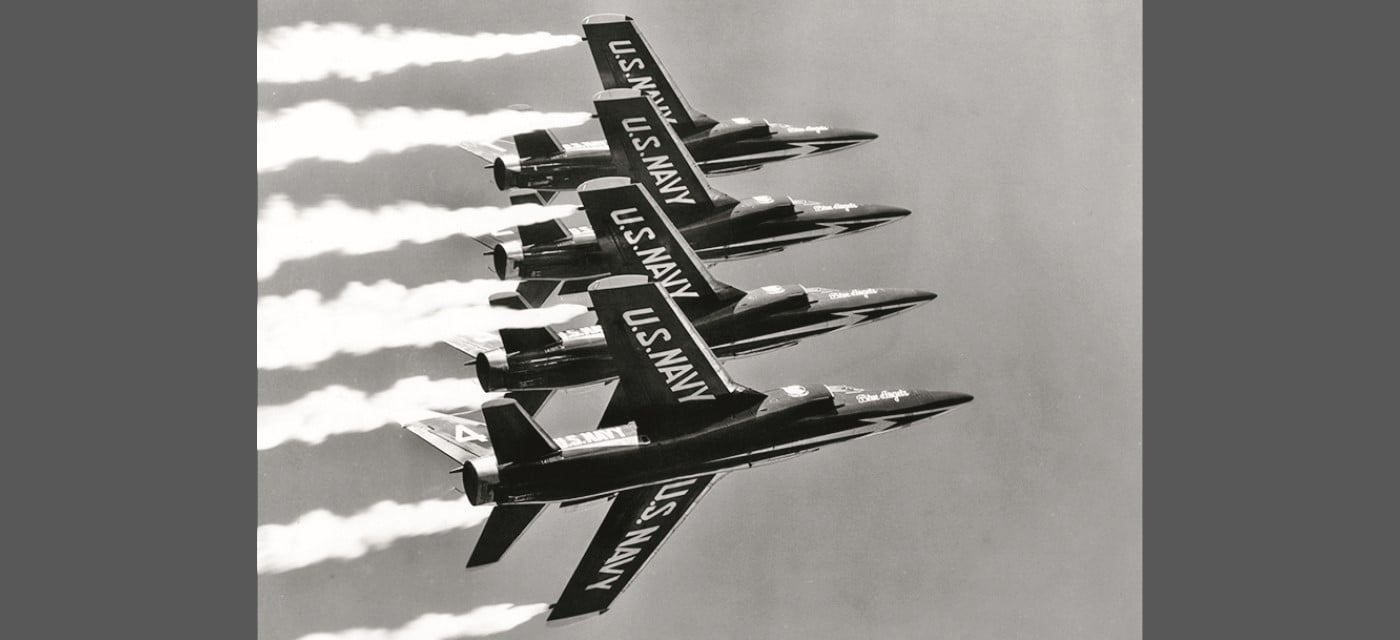
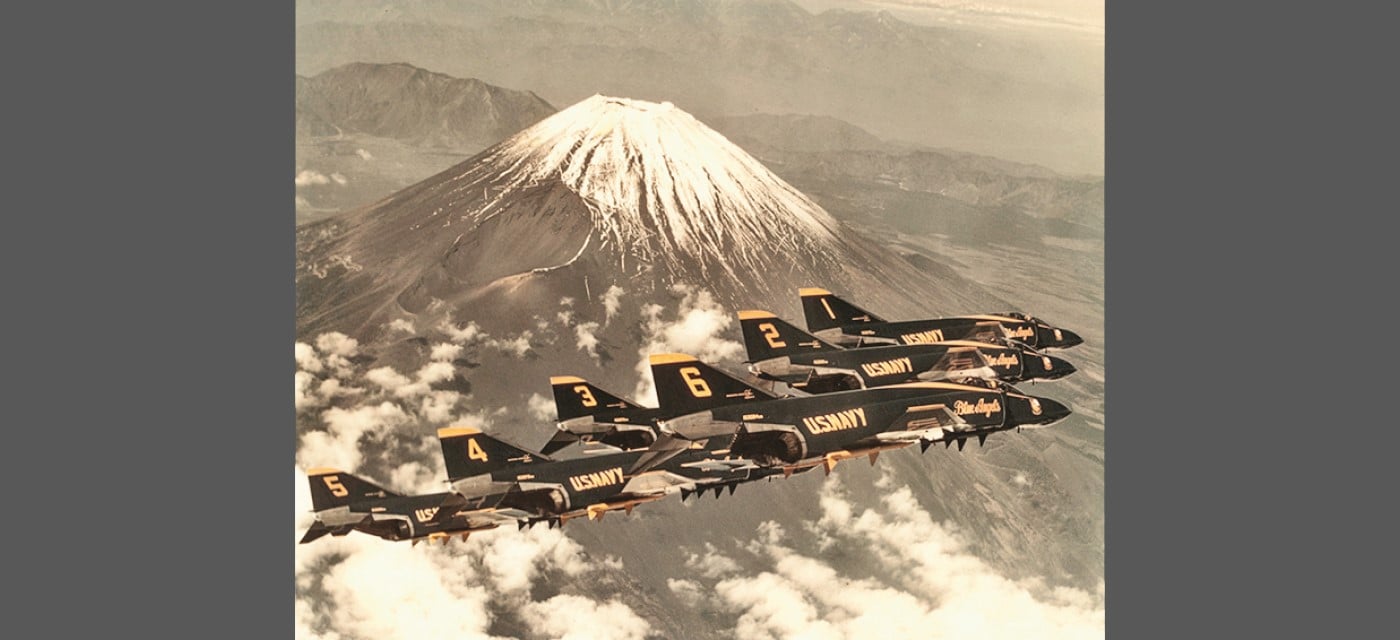
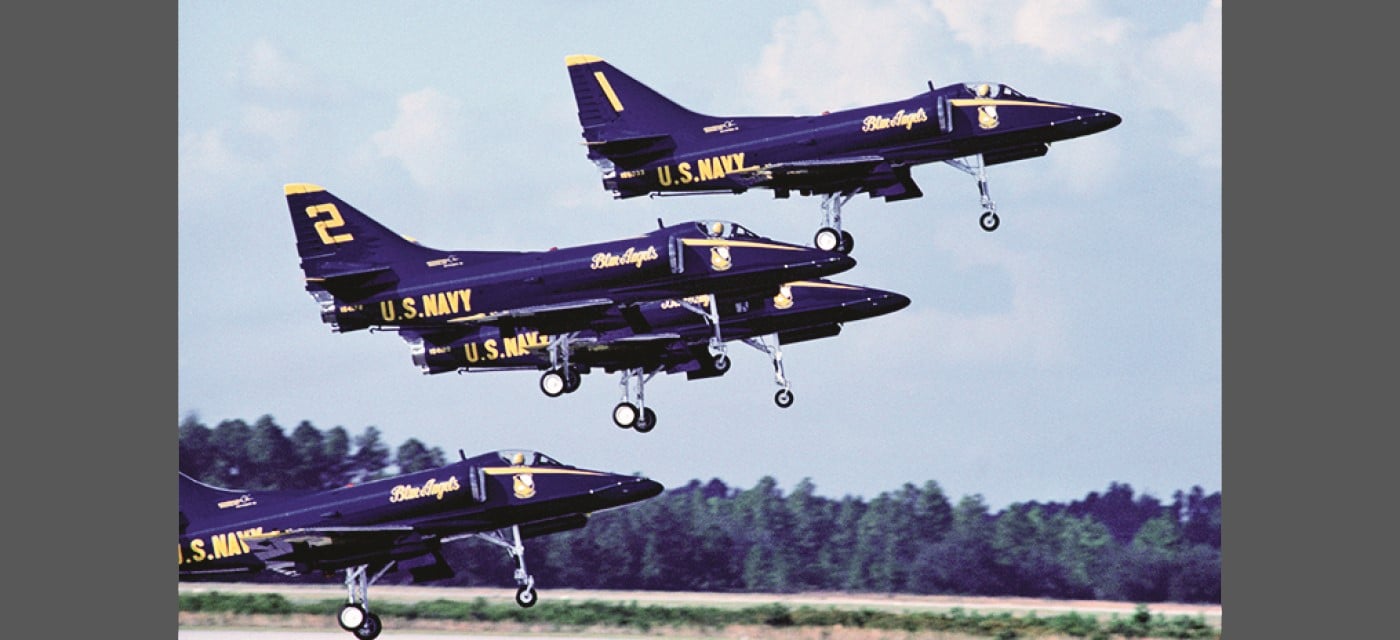
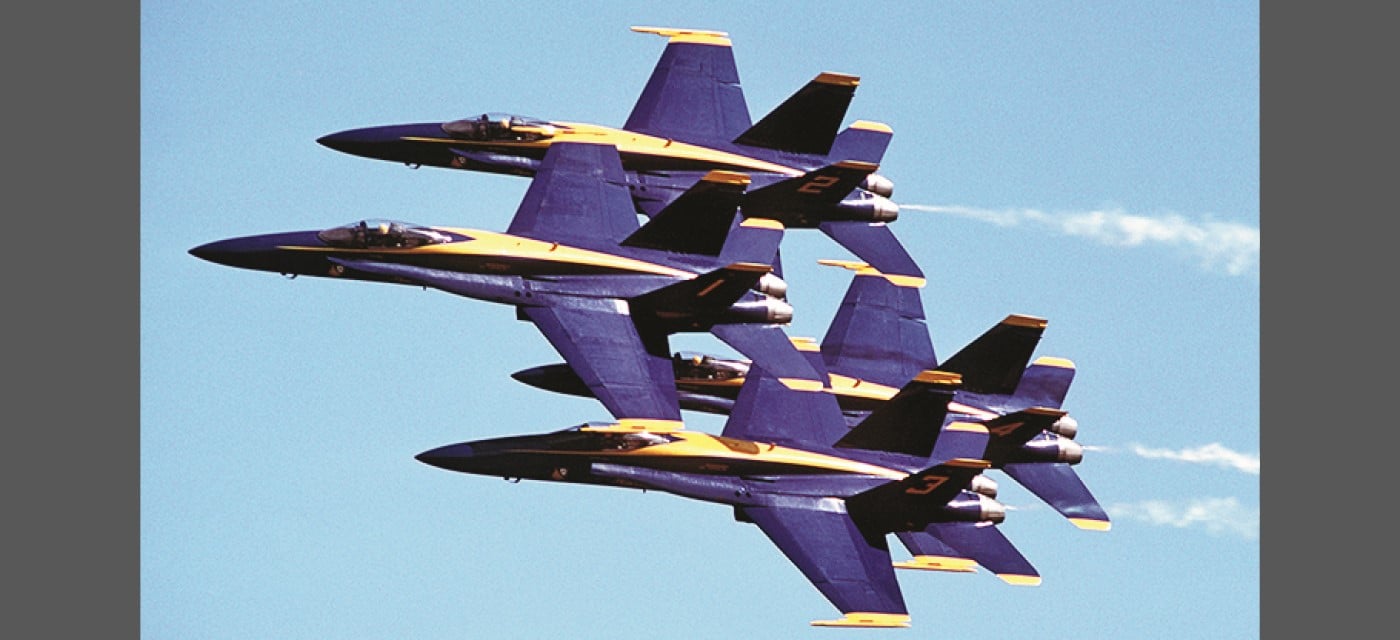
1946-1949: Hellcats and Bearcats
The debut team featured Grumman F6F-5 Hellcat fighters, but the powerful propeller-driven Grumman F8F Bearcat, pictured, soon became the standard demonstration aircraft. (Navy photo)
1949-1955: Panther Pride
The Grumman F9F-5 Panther, pictured, was the group’s mainstay during the early 1950s. The earlier F9F-2 model (1949-1950) was the unit’s first jet aircraft. (Navy photo)
1955-1968: Tigers in the Sky
The Grumman F11F-1 Tiger, pictured, replaced the F9F-8 Cougar in 1957 and flew with the Blues for 11 years. The aircraft was redesignated F-11A in 1962. (Navy photo)
1969-1974: Enter the Phantom
The McDonnell F-4J Phantom II was the Blues aircraft for much of the Vietnam era. After two serious accidents in 1973, one in which three pilots were killed, the decision was made to retire the Phantom. (Navy photo)
1974-1986: Soaring Skyhawks
The Douglas A-4F Skyhawk II, nimble and much smaller than the Phantom, debuted with the Blues in 1974 and spent 12 years with the organization. (Navy photo)
1986-2020: Hornets Take Flight
The McDonnell Douglas F/A-18A Hornet, pictured, became the Blues demonstration aircraft in 1986, joined in 2010 by the upgraded Boeing F/A18C. Together, the “legacy” Hornets flew 34 years. (Navy photo)
By any measure, the Blue Angels have succeeded in their original mission to keep the American public aware of the Navy and of naval aviation, to stir pride and boost morale.
Wildly popular, they are featured in dozens of air shows across the country, beginning most years in March and running through November. A full season can mean performing in up to 34 shows, the number of events they were part of during 2019.
The arrival of the COVID-19 pandemic in 2020, of course, caused the cancellation of most huge air shows as lockdowns and social distancing replaced large public gatherings.
But last April, the Blues and their Air Force counterparts, the Thunderbirds, joined in a show of solidarity to perform a series of flyovers around the country. Dubbed Operation America Strong, the joint effort was meant to salute and appreciate health care workers, first responders, and essential personnel for their work during the pandemic.
Thousands of people emerged from isolation to watch and cheer the planes, and social media buzzed with excitement and videos of the demonstrations. Along with numerous other service aircraft, the effort continued into the summer and boosted morale wherever the aircraft appeared.
The 2020 flying season was a variation on a theme for the Blue Angels since the flight demonstration team was formed in early 1946 at the direction of Chief of Naval Operations Adm. Chester Nimitz. The man who led the Navy’s Pacific operations during World War II realized that, with the war over and millions of servicemembers returning to civilian life, an effort was needed to keep the Navy in the public eye.
Nimitz “wanted something that was visible, visual, professional, and impressive, that would resonate with people,” Bartlett said. “He wanted people to know what the Navy was all about.”
75 Years Ago
In March 1946, Lt. Cmdr. Roy “Butch” Voris, a fighter ace during the war, formed the unit at Naval Air Station Jacksonville, Fla. At their home base on June 15, 1946, flying Grumman F6F-5 Hellcat fighters, the team performed its first show.
What was then known as the Navy Flight Exhibition Team was only the world’s second military flying demonstration team, following a French Air Force team first formed in 1931.
The Blue Angels name was first used in July 1946 and was suggested, according to the team’s official history, by team Right Wing pilot Lt. Maurice “Wick” Wickendoll. In August that year the team made its first significant change of aircraft, switching to the higher-powered Grumman F8F-1 Bearcat, at the time the Navy’s fastest carrier plane. In the late summer of 1949, the team traded in their Bearcats for their first jet, the Grumman F9F-2 Panther.
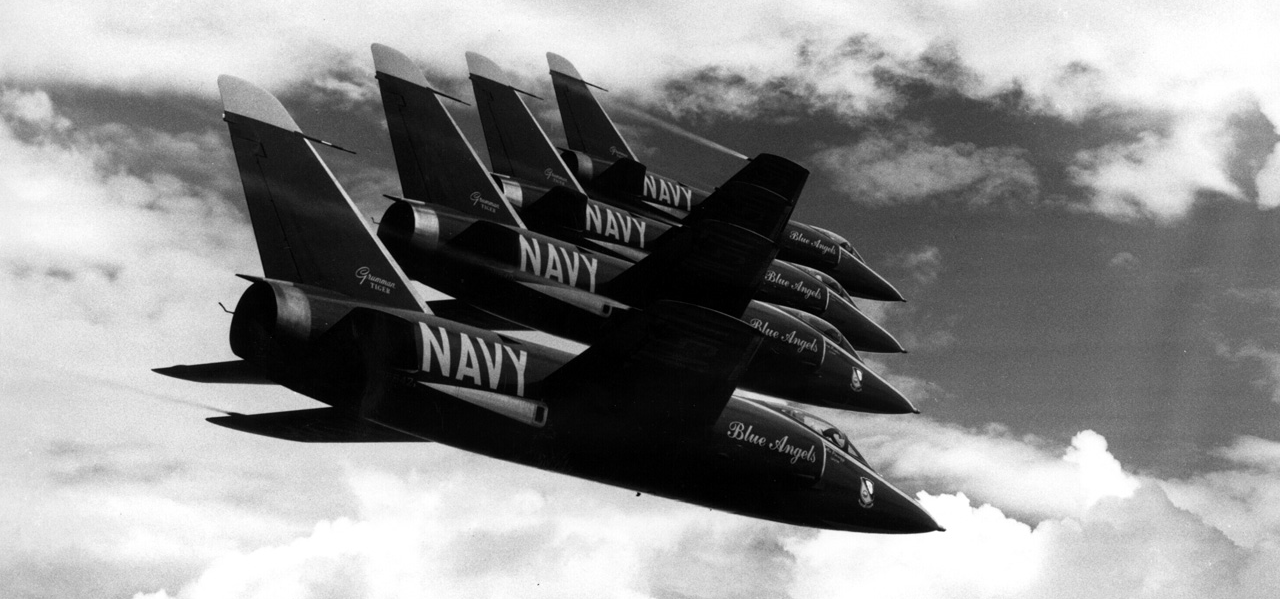
The Blue Angels in formation in 1957. (Navy photo)
Along the way the team developed show routines. Bartlett recalled meeting Voris in October 2004, when the team performed a tribute to their then-85-year-old first commanding officer. Voris died the following year.
“I sat with him at dinner,” Bartlett said, “and asked him, ‘Boss, so back in 1946, you were flying propeller-driven airplanes, this was all new, and Chester Nimitz says you go figure it out. So how did you decide how close together to fly the airplanes?’
“He says, ‘Well boss, if we hit each other, we knew we were too close together. And if we didn’t hit each other, we were too far apart.’ ”
As the shows evolved and aircraft became bigger, faster, and more powerful, the team experienced its share of accidents from a variety of causes, from bird strikes to equipment failures to mid-air collisions, in practice and during performances. Twenty pilots and one crew member have died, the first in 1946 and the most recent in 2016.
Perhaps the worst accident was in July 1973. The team had switched to the McDonnell F-4J Phantom II in 1969, but the huge aircraft was overpowered and difficult to handle in the kind of close, precision flying practiced by the Blues. The last of several serious incidents took place on July 26, 1973, when two of the two-seat aircraft collided over Lakehurst, N.J., killing three, including flight leader and commanding officer Lt. Cmdr. Marvin “Skip” Umstead.
The rest of the season was canceled, and the team switched to the smaller and more nimble Douglas A-4F Skyhawk. Safety procedures were also changed.
‘For the Good of the Team’
The intensity begins each year in the winter training season at Naval Air Facility El Centro, Calif., where pilots go up two or three times a day followed by a detailed debriefing, attended by the entire support crew.
“From when the pilots walk to the airplane, the entire demonstration is filmed by our crew,” Bartlett said. “Then the debriefs are really where the magic happens. The guys will go through and look at every maneuver frame by frame — it’s generally a two- to three-hour debrief for every 35-minute flight. So it’s brutal. But that’s where you figure out what you’re doing well and what you need to work on.
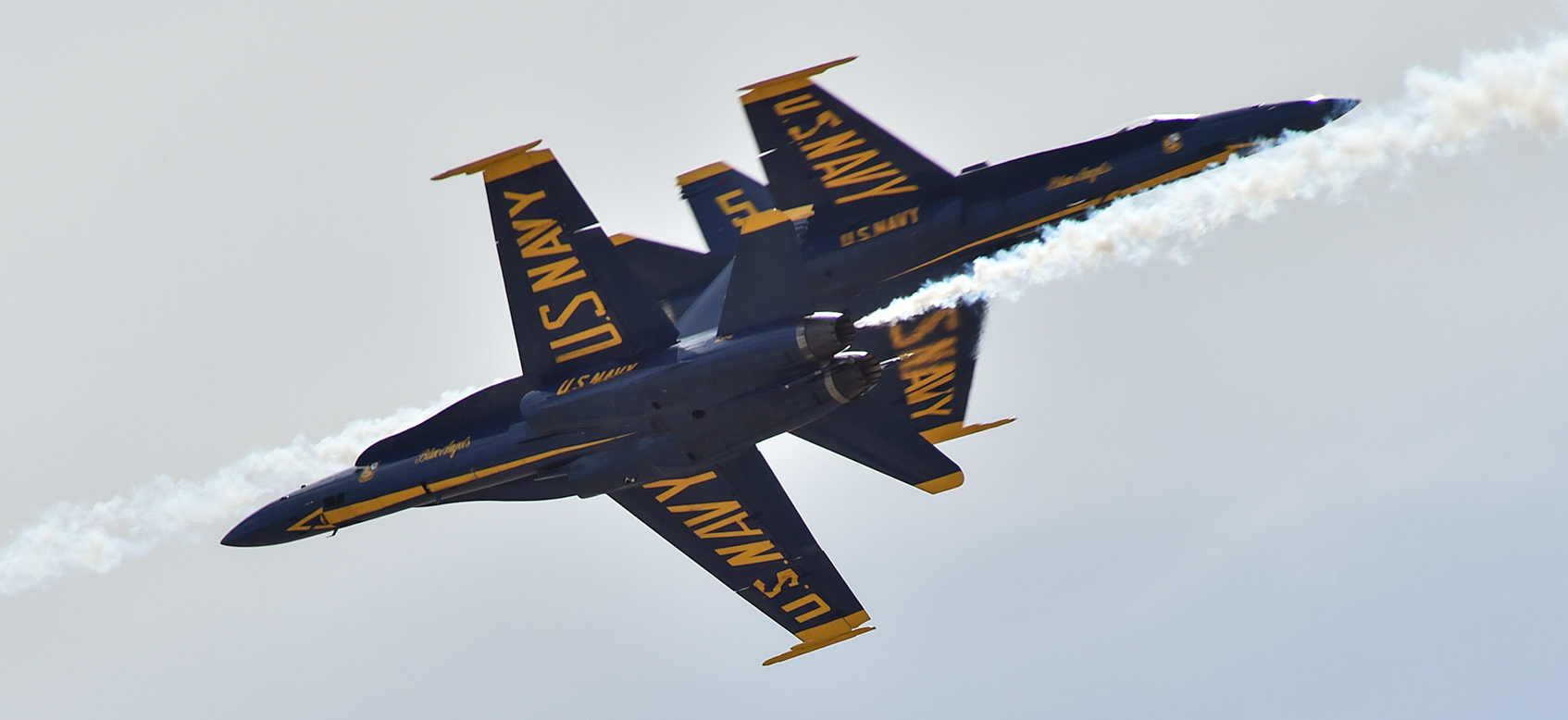
The Blue Angels in action during a 2017 air show. (Navy photo)
“Everybody is expected to participate. There’s no ego in there. It doesn’t matter if you’re the boss or the supply officer, you’re expected to participate and help us identify things that any one of us can do better tomorrow,” Bartlett said. “That’s the cultural thing that was different from every other unit I was in. Everybody’s empowered and expected to speak up. If you need to call out the boss because he did something incorrectly, you do that for the good of the team.”
The winter training at El Centro involves every member of the unit.
“We break it down to the very basics, whether they be support personnel or pilots,” Cmdr. Brian Kesselring, the team’s current commanding officer and flight leader, told Military Officer.
“We start out with takeoff. We spread the formation way out, start doing drills. Put the speed breaks together, start doing basic turns,” Kesselring said during a break in training at El Centro.
Training begins at the team’s home base at Naval Air Station Pensacola, Fla., “then we get out here for a really intense regimen,” he said. “We fly six days a week. We alternate every other day — we’ll have three flights per person on every other day, then two flights per day on the others,” he added. “What we do requires that.”
The New Super Hornet
The training since the fall of 2020 has been even more intense as the group transitioned to the Boeing F/A-18E Super Hornet, trading in the “legacy” F/A-18 A/B/C/D Hornets flown since 1986.
The Super Hornet “is about a third bigger,” Kesselring said. “It’s got a bigger engine, is more modern, and has more redundancy. It’s got a different flight control system, and it will maneuver just slightly differently.”
The Super Hornet’s excellent low speed performance will allow the Blues to get a bit closer to spectators.
“Our solos will incorporate some of the maneuvers — the pitch authority, if you will — to be able to go from a nose-high to nose-low flight regime very quickly, things you really can’t do in a Hornet,” Kesselring said. “You’ll be able to see the slow-speed handling characteristics of the Super Hornet as well as the faster passes.”
New Life for ‘Legacy’ Aircraft
The unit’s discarding of its older Hornets proved a bonanza for several aviation museums, which vied to acquire a genuine Blue Angel aircraft.
One of the winners was the Hickory Aviation Museum in Hickory, N.C., which received the No. 5 plane.
“We were lucky to have our aircraft flown in by a former Blue Angel who still does work with them,” said Lt. Cmdr. Bill Baker, USN (Ret), a former naval flight officer and MOAA member who works with the museum.
The aircraft arrived in November 2020 and goes on display this spring.
The plane has generated much interest in the surrounding area, Baker said. Several hundred people showed up just to watch the aircraft arrive.
He expects the Blue Angel aircraft to be more popular than the museum’s F-4 Phantom or F-14 Tomcat.
Social media has lit up with news of the aircraft going on display, Baker said.
“People are excited. The city is excited!”
2021 Air Shows
Here are season dates for the Navy’s Blue Angels and the Air Force’s Thunderbirds flight demonstration teams. Their shows will take place throughout the country during the season. Schedules may change without notice. Before attending a show, it’s best to check the teams’ websites.
- Blue Angels: Opening: April 17-18 in Lakeland, Fla.; Closing: Nov. 5-6 at NAS Pensacola, Fla.
- Thunderbirds: Opening: Feb. 14 (Daytona 500 flyover); Closing: Nov. 6-7 at Davis-Monthan AFB, Ariz.
Christopher P. Cavas is a naval journalist and commentator based in the Washington, D.C., area. He is on Twitter @CavasShips.
MOAA Knows Why You Serve
We understand the needs and concerns of military families – and we’re here to help you meet life’s challenges along the way. Join MOAA now and get the support you need.
